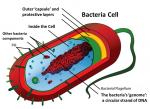|
This section contains 371 words (approx. 2 pages at 300 words per page) |
The Eubacteria are the largest and most diverse taxonomic group of bacteria. Some scientists regard the Eubacteria group as an artificial assemblage, merely a group of convenience rather than a natural grouping. Other scientists regard Eubacteria as comprising their own kingdom. Another recent classification holds Eubacteria and Archaebacteria as domains or major groupings, classified above the kingdom level. The Eubacteria are all easily stained, rod-shaped or spherical bacteria. They are generally unicellular, but a small number of multicellular forms do occur. They can be motile or non-motile and the motile forms are frequently characterized by the presence of numerous flagellae. Many of the ecologically important bacteria responsible for the fixation of nitrogen, such as Azotobacter and Rhizobium, are found in this group.
The cell walls of all of these species are relatively thick and unchanging, thus shape is generally constant within groups found in the Eubacteria. Thick cell walls are an evolutionary adaptation that allows survival in extreme situations where thinner walled bacteria would dry out. Some of the bacteria are gram positive while others are gram negative. One commonality that can be found within the group is that they all reproduce by transverse binary fission, although not all bacteria that reproduce in this manner are members of this group.
Eubacteria are often classified according to the manner in which they gain energy. Photoautotrophic Eubacteria manufacture their own energy through photosynthesis. Cyanobacteria, often called blue-green algae, are common photoautotrophic Eubacteria that are found in ponds and wetlands. Although not true algae, Cyanobacteria grow in chain-like colonies and contain chloroplasts as do aquatic algae. Cyanobacteria fossils are among the oldest-known fossils on Earth, some more than 3.5 billion years old.
Heterotrphic Eubacteria depend upon organic molecules to provide a source of energy. Heterotrophic Eubacteria are among the most abundant and diverse bacteria on Earth, and include bacteria that live as parasites, decomposers of organic material (saprophytes), as well as many pathogens (disease-causing bacteria). Chemoautotrophic Eubacteria bacteria obtain their own energy by the oxidation of inorganic molecules. Chemoautotrophic bacteria are responsible for releasing the sulfur resulting in a sulfur taste of freshwater near many beaches (such as in Florida), and for supplying nitrogen in a form able to be used by plants.
|
This section contains 371 words (approx. 2 pages at 300 words per page) |


